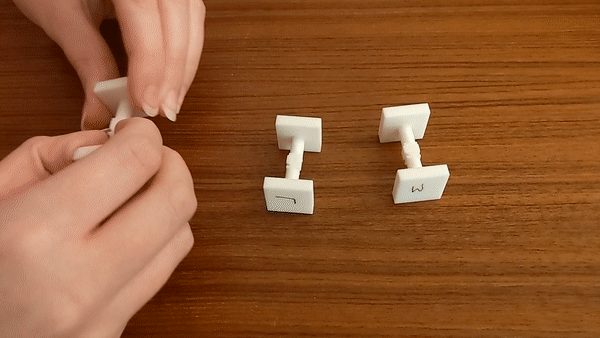3D Printed Snap Connectors that Print as One Piece!
- Caleigh Goodwin-Schoen

- Aug 30, 2020
- 3 min read
SLS Nylon 12 snap-fit connectors that print pre-attached in a single .STL file.

Plastic snap-fit connectors are nothing new in the mechanical world. They make use of plastic's elastic properties during deformation, by temporarily bending cantilevered beams. Once released, the beams snap back into place with no damage to the part. The beams are typically not simple rectangular shapes however. The unique shape of the beams can be customized to determine how easy it is for the user to move the connector in specific directions.
For example, a standard buckle that you would find, for example, in a shopping cart seat for infants, is curved on the outer edge so that is easy to insert, but has a hooked corner, so that once the buckle is in a connected position, it is difficult to disconnect by simply pulling apart. I wanted to recreate something similar for use in 3D printed protein models, but focus on creating a connector which printed as one single piece. The nature of selective laser sintering allows this to occur because the layers of powder function as the support material that you would generally find in fused deposition modeling, but there is no extra processing needed to remove the support, since the powder simply falls out. Another advantage of SLS for snap connectors is that there are no directional differences in strength, so the part can be printed in any orientation without the concern of layers splitting apart.
The main goal of my summer research project was to increase public access to 3D printed protein models with seperable pieces, and having the option to print them as one whole piece significantly increases their affordability.
Creating a one-piece snap connector that is reusable hundreds of times without the need for manual reshaping was beyond the scope of my project, but I hope that I or someone else can pursue it further. I think it has many potential uses in creative and scientific communities.
I made 13 prototypes total, and 7 were successful at meeting the following criteria:
Configuration prints in one piece
Parts are seperable (not fused together)
Pieces do not slide out without applied force
Connector is restricted from rotating to some extent
Assembly does not break with light use
Out of the models for my first 3D Printing trial, these are the ones that met the requirements.
From left to right: Tri-socket, duo-socket, screw, side-release buckle.
The socket connectors required the same very small force to pull out as they did to push in, which was unappealing for protein models. They also rotated a lot more than desired. The screw worked surprisingly well, and could tolerate the most pull-out force without detaching, but I figured that due to the shape of the protein pieces they would be attached to, it might not be possible to twist them around a helical path without interference. The final option, and the winner of round 1, was the side release buckle. It could be attached and detached straight on, meaning there wouldn't be protein model interferences, it barely wobbled or rotated, and it did not separate without moderate applied force. However, it actually required more force to join the pieces than it did to separate them due to internal fillets, and the release tabs were very had to access. This inspired round 2 of trial connectors.
Final major designs for connectors. From left to right: short cantilever, long, and wide-set.
I ended up printing out 6 connector sets: the three designs above, and then the same ones but with different clearance values. The low-clearance connectors ended up printing in an inseparable state (they were fused together) while the high clearance ones turned out well.
The above videos are in real time! As you can see, the connectors are very user friendly.
They are extremely easy to insert, and fairly simple to separate as well, using the side tabs. They have a lot of strength, however, opposing the action of pulling straight out, which is useful for many applications.
Namely, for the 3D printed protein models project, this allows students and researchers to take apart models as they please, without sacrificing structural integrity when the model is put together. While printing the connectors in one piece means the segments need to have a higher clearance, their rectangular shape and low clearances ensure that rotation is minimal.

Out of all the connectors, the one with long cantilevers experienced the least amount of deformation after repeatedly connecting and disconnecting the pieces. That is the most important feature for my 3D printed protein models project, but the other connectors have different advantages. The wide one wobbles the least, and the short one has the largest tabs to press, meaning it is the most user friendly. For convenience, all three .STL files are available in this Google Drive folder.

























Comments